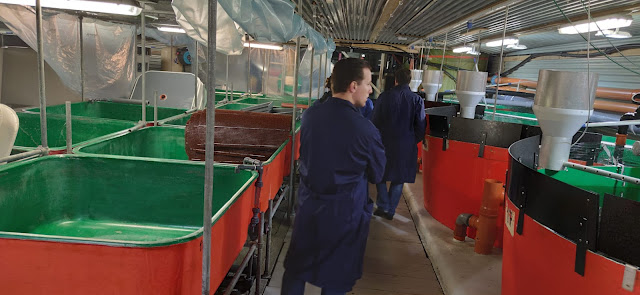Visiting fish plants Salmar and Nekton on August 24 2022 - Fish2Fork Week in Molde
The second day of the tour offered a unique opportunity to the project researchers: a visit to two fishfarms – Nekton and Salmar – in order to better understand all the stages of the aquaculture production process.
The Portuguese and Norwegian teams left Molde in the morning of August 24 towards Kristiansund where, due to good weather, they were allowed to use a rib to reach the island of Smøla. The researchers dressed up and embarked on this adventure through the Norwegian Sea, which lasted approximately 30 minutes.
Upon the arrival at the Nekton company, the teams were welcomed by Bruna Skipnes, a brazilian biologist who has been operating in these facilities for many years, and who facilitated a tour in Portuguese for visitors. The visit started at the stage of growth of fish eggs (salmon), where they are stored for about 10 weeks. It was explained how this phase is extremely delicate, so the room is kept at a constant temperature and the employees only touch the eggs once a week to ensure their growth and evolution.
Then, the group moved on to the interior tanks, which contained hundreds of small fish in a very young stage. In these tanks, there is a continuous water current that helps the development of the animals that need to swim and stay active in order to grow.
 |
| Figure 4 - Tour inside Nekton facilities |
The final stage of production on land is carried out in external ponds much larger than the previous ones, since the salmon will remain in this place until it reaches 80 to 200g, at which time it is ready to be transferred to the sea.
 |
| Figure 5 - External tanks in Nekton |
In addition, Bruna explained that the animals are fed automatically using pre-defined amounts (in order to avoid waste) and that all individuals of the species are vaccinated before being placed in external tanks, which use the rivers as a water resource. Despite all these precautions, mortality in these facilities is just below 10% and it is sometimes necessary to use probiotics to fight ulcers or other diseases that arise.
This visit proved to be extremely educational and interesting, and was the topic of discussion by the researchers during lunch, offered in Gurisenteret. This place seeks to preserve the identity and history of Norway, so the teams were entitled to a typical Norwegian song sung by a native and the opportunity to try different regional products, which were duly presented by the same lady.
 |
| Figure 6 - Lunch at Gurisenteret |
To complete the salmon growth process, the research team was invited to visit the final stage at the sea. The Salmar company facilitated access for researchers to its production, where the fish is kept between 14 and 18 months, or until they reach a minimum size for consumption/sale. Exposure to the marine environment and its fauna and flora potentiates the development of plagues. Consequently, employees apply cleaner fish and perform sample testing, avoiding the use of medicines as much as possible. However, mortality in Norwegian fishfarms is currently at 20% of all production.
 |
| Figure 7 - Salmar fishfarms in the ocean |
Fish2Fork - Improving skills and competencies for monitoring the fisheries process up to the final customer
Website: www.fish2fork.eu | Email: info@fish2fork.eu
Blogue PT: fish2fork.blogspot.com | EN Blog: fish2fork-en.blogspot.com
LinkedIn page: www.linkedin.com/company/fish2fork-inov
Facebook page: www.facebook.com/Fish2Fork.INOV
Instagram: www.instagram.com/fish2fork
Twitter: https://twitter.com/Fish2forkIYouTube: https://www.youtube.com/channel/UCYy-Db_Ppn_Hkmbl6xhGETQ




Comments